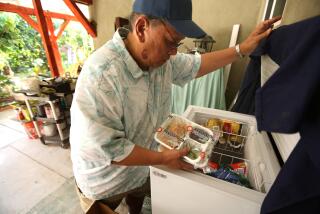Ignorance, Harassment Keep Millions From Seeking Welfare Benefits : Poverty: If more eligible people applied for aid, the programs would cost the government billions of dollars.
- Share via
EMPORIA, Va. — Harriet Clary’s daughter came home with her baby and left after a year. For 17 years Clary and her husband reared their grandchild, sometimes with their daughter’s help and sometimes without it.
In recent years, leg pains forced Clary to quit her mill job, and the family has been living on her disabled husband’s disability check of about $566 a month, but it never really occurred to Clary, whose education ended in the second grade, that other help might be available.
Dealing with “the welfare folk,” as she calls them, was never a pleasant experience.
“They scare me to death when they talk to me, the welfare folk. I’m just scared,” she said, adding, “They make you feel small.”
A year ago she came to the Virginia Legal Aid Society office here after finding out that the leg pains she experienced may have qualified her for disability payments from the federal Supplemental Security Income (SSI) program.
She found that for most of the time she had been rearing her granddaughter, she could have received payments from another federal program as well--Aid to Families with Dependent Children (AFDC).
Through ignorance and fear, Clary lost thousands of dollars of benefits, according to Legal Aid officials, and those benefits cannot be recovered. Her case, outlined in an interview at the Virginia Legal Aid office here, is not unusual.
Although efforts to trim welfare rolls by tightening eligibility standards have traditionally generated considerable controversy, especially in the early years of the Ronald Reagan Administration, relatively little attention has been focused on the millions of people believed to be eligible for welfare benefits who, for a variety of reasons, are not receiving them.
Failure to receive the benefits is not the result of any budget constraints. The federal and state governments automatically pay out whatever is needed to provide benefits to anyone who is eligible for major programs since there are no effective spending ceilings.
The implications of millions of the poor or near-poor failing to receive billions of dollars designed to reach them are not lost on experts, both as an indication of the effectiveness of the “safety net” provided by the nation’s welfare system and as a further potential fact in the budget deficit.
“If more eligible people enrolled, outlays would be substantially higher, probably billions more, but the result would be fewer people in poverty, in need of food or lacking medical care,” said Robert Greenstein, a former administrator of the Food and Nutrition Service, now director of the Center on Budget and Policy Priorities.
Recent studies have documented the extent of under-enrollment in major federal programs:
* One-third to one-half of all persons legally eligible for food stamps are not enrolled, according to studies by the Congressional Budget Office, Mathematica Policy Research (done for the Agriculture Department) and the General Accounting Office.
The budget office and Mathematica studies found that in mid-1984 about 30.4 million people were eligible but at most only 20 million were enrolled. Enrollment may have been as low as 15.6 million, the Congressional Budget Office said.
* A third to a half of those eligible for SSI, a cash welfare program for the aged, blind and disabled run by the Social Security Administration, are not enrolled. A study by ICF Inc. for the American Assn. of Retired Persons concluded that in 1985, looking at those age 65 and over, only about 2 million were enrolled in SSI, although 3.8 million persons were eligible--a 51.5% participation rate.
The association said estimates at Brandeis University put the figure somewhat higher--64%. The Social Security Administration said a 50% rate “is not inconsistent” with its past estimates.
* From 20% to 25% of the 4.2 million families eligible for AFDC, the cash welfare program for mothers with small children, do not participate, an Urban Institute study covering 1984 found.
* A third of all non-institutionalized, low-income people eligible for Medicaid are not enrolled, according to preliminary findings by the Urban Institute.
In 1987, these four programs alone paid out about $95 billion in benefits to people who were enrolled.
The reasons why people do not enroll vary. General Accounting Office and other studies suggest that in up to half the cases the reason is lack of knowledge.
Many don’t know the programs exist. Others mistakenly believe they are ineligible--particularly the working poor, who sometimes assume that anyone with a job is not eligible. Still others are semi-literate, fear dealing with the government and simply do not know how to “negotiate the system.”
Other factors cited in surveys are embarrassment at applying for “charity,” particularly among formerly middle-class older people who have fallen on hard times; mistreatment and administrative obstacles sometimes imposed by welfare officials; the feeling of some that they don’t need benefits even if eligible; and the fact that the income of some eligible people is high enough that benefits would be small, often only $10 a month.
A GAO report said that although lack of knowledge explained about half the non-participation of eligible people in food stamps, another factor was “administrative hassle.”
Another GAO study found some local food stamp offices only were open four days a week; others did not help applicants obtain documents they needed for proper application, and some welfare offices improperly terminated food-stamp benefits automatically whenever a person was no longer eligible for AFDC or other cash benefits, even though food stamps have different and more liberal rules.
An important factor in people’s failing to get food stamps, according to Robert Fersh, director of the Food and Nutrition Action Center, “is lack of forceful and strong outreach efforts . . . the Reagan Administration in effect acquiesced in 1981 in the abolition of federal outreach funding, which will only come back into effect on July 1 as a result of legislation last fall.”
Advocacy groups and members of Congress have urged other programs to improve their “outreach” programs as well.
“Unfortunately, a safety net does no good if it’s kept inside a bureaucrat’s desk,” said Ronald F. Pollack, director of the Villers Foundation.
Testifying before a House committee recently, Deputy Social Security Commissioner Michael C. Carozza defended the agency’s outreach efforts and said: “Since July, 1983, each month approximately 110,000 potential beneficiaries have been notified about the SSI program and its eligibility requirements at the time they receive notification of eligibility for Medicare.”
But Rep. Mickey Leland (D-Tex.) was not convinced. “Most benefit programs seem to be operated under the assumption that everyone can read and write, that everyone has a car and that everyone has endless hours to spend finding offices, obtaining documents and waiting to be interviewed,” he said.
Harriet Clary’s story, involving two benefits, illustrates why many people don’t get help.
Seventeen years ago she took her infant granddaughter into her home in Brodnax, a small town 35 miles south of Emporia. The child’s mother lived there too for a while, but moved out later that year, leaving the child with Clary.
Since then the girl has lived with her mother from time to time, but most of the time with Clary and her husband. The mother has been able to make a contribution toward the child’s support only occasionally.
Under federal welfare law, when a child with little or no income is living with a “caretaker” relative who is not the child’s parent, such as a grandmother or aunt, the child can receive an Aid to Families with Dependent Children benefit even if the “caretaker” has income above the welfare cutoff.
Clary’s granddaughter fit this profile, so for the last year and half, the most recent period when the child has been living at the Clary residence, Clary could have applied for a monthly AFDC payment for the child--a payment that today would be $131 a month and would have totaled close to $2,000 just since the start of 1988.
The child would also have qualified for years of AFDC benefits, totaling many thousands of dollars, at earlier periods when she was living with Clary rather than her mother, which has been most of her life.
Clary learned of her granddaughter’s eligibility for an AFDC payment only last year, when she turned to the Virginia Legal Aid Society office in Emporia for help with a different matter--her own leg problems.
She knew there was a federal welfare program that included disability (SSI), but “my doctor didn’t tell me to apply so I assumed I wouldn’t get it.” But about a year ago she finally applied.
At Virginia Legal Aid she met Kathy Bicking, a dynamic paralegal worker who was once a welfare mother. Bicking discovered that Clary’s granddaughter has been eligible for an AFDC cash payment.
“Illiteracy plays a big part with clients here in Virginia,” said Bicking. “They can’t handle the forms. And people who were once denied benefits, even when their situation has changed, carry with them the idea that they’ll never be eligible again.
“Then there is ignorance of the procedures and of their rights. People denied disability benefits sometimes don’t even appeal, because they figure that the agency knows what it’s talking about. But when we represent them, we discover they are eligible.
“Then there are ignorance, hostility and nastiness on the part of welfare workers, though it’s not the most common explanation. I didn’t hear this myself but I was told one (worker) said, ‘I like to see them crawl a little.’ ”
Mary Queen Nicholson, 36, who stopped school in fifth grade and is legally separated from her husband, was one such victim.
Her household lost its food stamps last year when her son, the only employed member, quit his job. She can’t explain why he quit.
The household broke up. She went to live with a cousin, but “I got no kind of income, no job.” She went to a social-services office and was given a bag of food. She said she was told, “Don’t come back for no more food. I’m going to help you this time, but never again.”
Nicholson thought she was being told she couldn’t get anything--no more food bags, no food stamps. After a few months, with no job, no money and food running short, “I just made up my mind to come over here,” Nicholson said. “At the end of January Miss Bicking got me food stamps--$90 a month now.”
More to Read
Sign up for Essential California
The most important California stories and recommendations in your inbox every morning.
You may occasionally receive promotional content from the Los Angeles Times.










